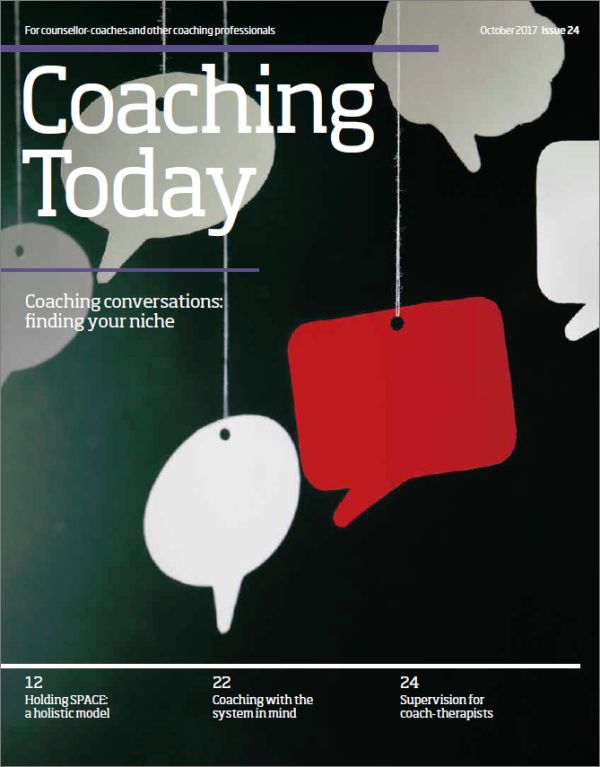In this issue
Features
Coaching conversations: finding your niche (free article)
Sally Brown
The SPACE coaching model: an integrative tool for coach therapists
Rachel Weiss, Nick Edgerton and Professor Stephen Palmer
Coaching with the system in mind: how a model for the many works for the one
Ann Knights and Dr Alexandra Stubbings
Regulars

A pdf of this issue is available in the Coaching Today archive.
Editorial
Something I really appreciate about editing this journal of ours is that, with every issue, I always have the opportunity to learn something new. It’s a real privilege for me, as both editor and practitioner, to read about the work you are doing there in the field of dual and/or integrated coach-therapy practice, and as I read, I usually find something of interest I can apply to my own evolving practice, or an idea that chimes with an area of inquiry or concern to me.
When I started out as a dance movement psychotherapist, I had already been coaching for a number of years, and was exploring ways of integrating both practices. I had so many questions – who would I work with? And how? What was my unique selling point (USP) as a practitioner, and how would I reach my audience? At a practitioner workshop, I was advised: work with what your clients bring. Notice who and what you already attract and begin from that place. A fascinating conversation on this subject earlier this summer with our Executive Specialist for Communications, Sally Brown, led to her cover feature article for this issue on identifying our own niche as practitioners. Here, she has canvassed the views of some of our readers and leading practitioners in the field of coaching and dual/integrated practice, and their comments and advice make for inspirational and enlightening reading. You’ll also note in our Chair’s column and our new news section that coaching specific client groups and finding your niche will also be the theme of our forthcoming Working with Coaching event on 22 January 2018, which promises to be an informative and inspiring day.
Elsewhere in this issue, I am honoured to include feature articles that explore two models and frameworks of coaching practice. Consultant, coach and counsellor Rachel Weiss has joined forces with Nick Edgerton and Professor Stephen Palmer of the Centre for Coaching to outline for Coaching Today readers the SPACE model of practice – a holistic cognitive behavioural model of practice that is ideal for coach-counselling practitioners working integratively. Here, they provide a helpful step-by-step guide to the process and demonstrate its use in action, showing how it beautifully combines the ‘psychological and the practical’ and how it links with other, current models of practice.
I am also delighted to welcome the return of previous contributor, Ann Knights, who, along with her colleague and co-director, Dr Alexandra Stubbings, demonstrates the effectiveness of a model devised for organisational-level change, and how this can be effective for work with individuals. As someone who works with both individuals and groups within the mental health and the criminal justice systems and is concerned with the impact of the system on the individual, I found this systemic approach to change particularly fascinating.
We also launch a new series in this issue, in which the BACP Coaching Executive team invite you to contact them with your queries and concerns on an aspect of your practice. One question that continuously arises is that around supervision and the appropriateness of working with a particular practitioner when we work integratively or conduct a dual practice. I currently have three supervisors for different areas of my practice and it was something of a relief for me to read our Executive Specialist for Supervision, Steve Page’s, response to our reader’s question, that this is just as valid and appropriate as working with one supervisor might be for others.
If any aspect of this issue resonates with you, please do get in touch. The BACP Coaching Executive and I are always keen to hear from you, and I want to commission and publish articles on areas of practice and research that are relevant to you – whether that be training, supervision, marketing or any other issue that you find helpful, informative or inspirational.
Until next time…
Diane Parker
Editor
editorial@bacpcoaching.co.uk
